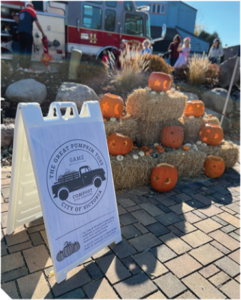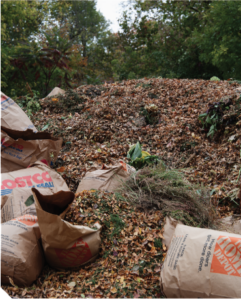Small Ideas for Big Impact
By Kendra Grahl
With a brief step onto one of our trails, into one of our parks, or along our lakes, people can see why our moniker is the “City of Lakes and Parks” in Victoria, Minnesota. We take a lot of pride in living up to our nickname. But as a smaller city, we know we need to use our resources wisely. For us, that means we need to focus on small ideas that can make a big impact.
A case study in promoting composting
The City of Victoria places importance on protecting the environment and all the natural features that make it unique. As environmental stewards, the city explores opportunities to protect and preserve the environment on the local level by looking to both innovative and tried-and-true approaches to fostering environmental sustainability.

While Victoria has facilitated composting activities in the past to promote responsible yard waste clean-up in the spring and fall, in 2022, the city made a concerted effort to increase composting as one of these approaches to environmental stewardship.
When disposed of properly, yard waste — such as grass clippings, leaves, and branches — can be turned into a valuable resource that can add nutrients back into the soil. The city determined Halloween was an opportune time to engage residents about composting, as our community members cleaned up their yards before the winter season. We specifically targeted the composting of pumpkins to showcase the benefits of composting and how easy it is to do.
Since families with children are more likely to have pumpkins as decorations during the fall, the city hosted a composting-related game during the annual Halloween event hosted by the local Lions Club and business association. This event attracts hundreds of families to downtown Victoria each year.
As part of our composting-related activity, we let participants throw balls into carved pumpkins so they could win a prize. Each element of the game was compostable, recyclable, or reusable. The pumpkin stands were made from local straw bales, the jack-o’-lanterns were real pumpkins, the balls were made from twine, and the prizes were small pumpkins and squash from a local farm.
With a hop and a toss — usually followed by a giggle — our community members were able to experience joy while they tried to win a prize. And we had a captive audience to talk to about why composting is so important. Each prize had a paper ‘Compost Me!’ sticker on it to remind people to compost their group of pumpkins with their other holiday decorations for the season.
During the event, each prize pumpkin as well as the jack-o’- lanterns were claimed by our younger community members who were ready to compost them once the season ended. The event resulted in an increase in awareness about the composting site, as well as an increase in the number of pumpkins dropped off that year. Overall, there was a 29% increase in compostable waste hauled out of the city’s compost site from the previous year.
This small idea had a big impact on our community and how we now approach our marketing efforts and awareness campaigns. Several factors went into play that contributed to its success.
Humanized our approach
Rather than focus on just educational posters or social media posts, we leaned into letting our community experience composting. The game let families laugh together and compete while we were able to have a two-way conversation with the participants. Many of the families we talked to during the activity were not aware that we had a composting site so it was an opportunity for them to learn about where it is located and get excited about what else they could compost. These memories were far more lasting for our community than a 10-second glance at a social media post.
Partnered with our community

The first year the initiative was created, the city hosted a mini fall festival after Halloween to encourage people to bring their pumpkins to the event to compost. Attendance was sparse, so for the next year, we partnered with our local Lions Club and business association since they already host an established Halloween event in downtown Victoria. To keep costs down for the activity, we borrowed the straw bales from a local dairy farm and purchased pumpkins from a local pumpkin farm.
By partnering with our community, we were able to have a much smaller budget than the fall festival but also reach hundreds more people and really focus our marketing and educational efforts on composting rather than also focusing on event planning.
Met people where they already were
Instead of trying to create a situation where we could educate people about the importance of composting or trying to force it at an unrelated meeting, we met people where they were already going to be receptive to information about fall activities. During the Halloween event, straw bales and pumpkins are already everywhere so it was an easy tie-in to talk about what could be done with this type of material at the end of the season and what else could be brought to the site as well.
We continue to take these small ideas that have served us well and apply them to new communication initiatives. We continue to think of other ways we can make small changes that will have a big impact. With a few small — yet strategic — ideas, cities can amplify their efforts in so many ways that can have a positive impact for years to come.
Kendra Grahl is communications and public engagement director for the City of Victoria.

